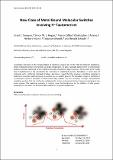Files in this item
New class of metal bound molecular switches involving H-tautomerism
Item metadata
| dc.contributor.author | Simpson, Grant James | |
| dc.contributor.author | Hogan, Simon William Leslie | |
| dc.contributor.author | Caffio, Marco | |
| dc.contributor.author | Adams, Christopher J. | |
| dc.contributor.author | Fruchtl, Herbert Anton | |
| dc.contributor.author | van Mourik, Tanja | |
| dc.contributor.author | Schaub, Renald | |
| dc.date.accessioned | 2015-02-02T14:31:03Z | |
| dc.date.available | 2015-02-02T14:31:03Z | |
| dc.date.issued | 2014-02-12 | |
| dc.identifier | 99857756 | |
| dc.identifier | 8e498e4e-9b80-4fc2-bc7a-c93c3d281e7d | |
| dc.identifier | 84894208252 | |
| dc.identifier | 000331343900036 | |
| dc.identifier.citation | Simpson , G J , Hogan , S W L , Caffio , M , Adams , C J , Fruchtl , H A , van Mourik , T & Schaub , R 2014 , ' New class of metal bound molecular switches involving H-tautomerism ' , Nano Letters , vol. 14 , no. 2 , pp. 634-639 . https://doi.org/10.1021/nl4038517 | en |
| dc.identifier.issn | 1530-6984 | |
| dc.identifier.other | ORCID: /0000-0001-7683-3293/work/57088459 | |
| dc.identifier.other | ORCID: /0000-0001-6647-4266/work/60887480 | |
| dc.identifier.uri | https://hdl.handle.net/10023/6050 | |
| dc.description | R.S. acknowledges the financial support from the Scottish Funding Council through EaStCHEM and SRDG grant HR07003. | en |
| dc.description.abstract | A potential end-point in the miniaturization of electronic devices lies in the field of molecular electronics, where molecules perform the function of single components. To date, hydrogen tautomerism in unimolecular switches has been restricted to the central macrocycle of porphyrin-type molecules. The present work reveals how H-tautomerism is the mechanism for switching in substituted quinone derivatives – a novel class of molecules with a different chemical structure. We hence reveal that the previous restrictions applying to tautomeric molecular switches bound to a surface are not valid in general. The activation energy of switching in a prototypical quinone derivative is determined using inelastic electron tunneling. Through computational modeling, we show that the mechanism underlying this process is tautomerisation of protons belonging to two amino groups. This switching property is retained upon functionalization by the addition of side groups, meaning that the switch can be chemically modified to fit specific applications. | |
| dc.format.extent | 2219588 | |
| dc.language.iso | eng | |
| dc.relation.ispartof | Nano Letters | en |
| dc.subject | STM | en |
| dc.subject | Tautomerisation | en |
| dc.subject | Molecular switches | en |
| dc.subject | Inelastic tunneling | en |
| dc.subject | QD Chemistry | en |
| dc.subject | BDC | en |
| dc.subject | R2C | en |
| dc.subject.lcc | QD | en |
| dc.title | New class of metal bound molecular switches involving H-tautomerism | en |
| dc.type | Journal article | en |
| dc.contributor.sponsor | Scottish Funding Council | en |
| dc.contributor.institution | University of St Andrews. School of Chemistry | en |
| dc.contributor.institution | University of St Andrews. EaSTCHEM | en |
| dc.identifier.doi | https://doi.org/10.1021/nl4038517 | |
| dc.description.status | Peer reviewed | en |
| dc.date.embargoedUntil | 2015-01-29 | |
| dc.identifier.grantnumber | SCISS HR07003 | en |
This item appears in the following Collection(s)
Items in the St Andrews Research Repository are protected by copyright, with all rights reserved, unless otherwise indicated.

